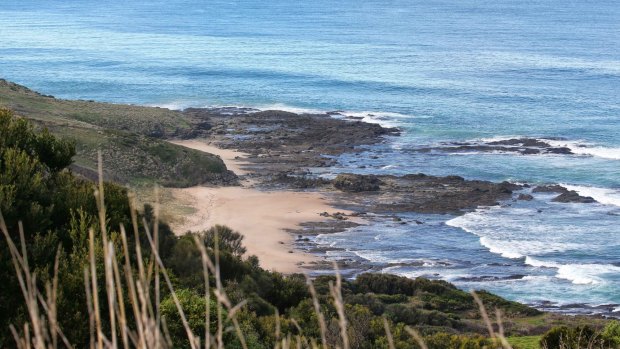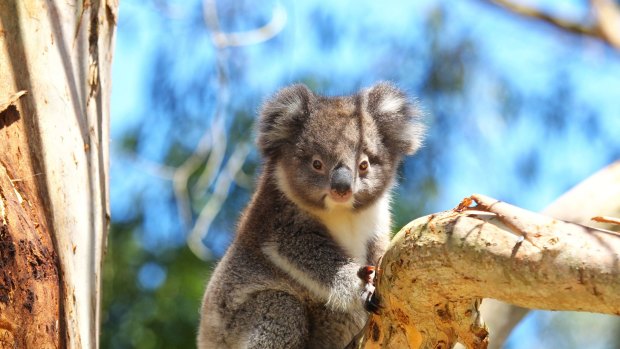This was published 4 years ago
Great Ocean Road: An exciting new Australian wildlife experience
By Julietta Jameson

Cape Otway. Credit: Phil Hines
Australia's precious wildlife has been making world news for terrible reasons, as bushfires ravaged huge tracts of habitat and shocking numbers of animals were killed and injured. But on Victoria's Great Ocean Road, a good news story has been quietly unfolding.
At Apollo Bay, a new $10-million wildlife park is set to open in mid-2020, with one of the key creatives behind New Zealand's hugely successful attraction, Hobbiton behind it.
Landscape designer of the award-winning Hobbiton, Brian Massey, who was also the art director on The Hobbit films, is working with local wildlife champions, Lizzie Corke and Shayne Neal on a 20-hectare property that it's hoped will encourage the Great Ocean Road region's millions of annual visitors to stay longer (and spend more).

The Otways have a strong koala population.Credit: Phil Hines
Corke was just awarded a Medal of the Order of Australia in this year's Australia Day Honours, "for service to conservation and the environment".
"At a time when we are experiencing the utter devastation of ecosystems and loss of billions of animals to bushfire it is fitting that that we recognise the contributions of someone who is working so hard to ensure a future for our iconic landscapes and species," the board of the Conservation Ecology Centre, of which Corke is CEO, wrote.
"From the moment they made their home on Victoria's Cape Otway, Lizzie and her husband Shayne have been dedicated to furthering our understanding of the Otways environment and working to conserve the plants and animals who live here."
The Great Ocean Road and Otways region, while no stranger to bushfire, has a strong koala population – in Cape Otway alone, it's been deemed "an over-abundance" by authorities.
Via the Conservation Ecology Centre which they founded in 2000 at Cape Otway, Corke and Neal have spent the better part of two decades working to preserve the diversity and habitat of the region, restoring the highly threatened quoll population, restoring health to the habitat with planting and controlled burning, and managing the plight of koalas.
In a place where the needs of farms and national park often butt against each other, the young couple has brought differing interests together and created real and positive change.
They came up with the idea of Wildlife Wonders as a way of generating funding for ecology projects, for supporting community and for education about the region's wildlife.
Wildlife Wonders will offer its visitors a walking tour by qualified conservationists through habitat where they will encounter native animals living freely. It may sound simple but Brian Massey's job is to balance the natural and free with the entertaining and memorable.
Massey agreed to help with Wildlife Wonders after the concept captured his vivid imagination. "If someone said to me, 'Help us build a zoo,' my answer would have been no," says Massey. "But this is what wildlife experiences are changing to. Lizzie and Shayne are leading the way and that was very appealing. People do want to see animals but as we become more enlightened, seeing animals in cages isn't doing it for us."
In the course of their conservation work, Corke and Neal had done plantings on a "sheep paddock" property that not only had its entry right on the Great Ocean Road just outside Apollo Bay, but also presented features that were perfect for encapsulating the beauty of the region and its animals. There was a substantial forested valley for the shyer species and a wide open plain for grazing kangaroos, not to mention sweeping ocean views affording whale watching opportunities.
Serendipitously, the farmer wanted to sell and the foundations of Wildlife Wonders were set when the couple took ownership in January 2019. It is, says Lizzie Corke, "the perfect canvas."
With "council hugely supportive as it ticks all their boxes: increased length of stay, nature-based experience, creating local employment," as Corke says, permits were secured for Wildlife Wonders and the couple gathered a 45-strong team to commence work, the first stage being plantings. That included the translocation of 300 tree ferns that were – again, serendipitously – being cleared to make way for a new fire access track in the hills behind Apollo bay. To date, all the trees have survived.
Though a great deal more work is being done to set it up, the idea is for the sanctuary to flow as nature intended. For Massey, the challenge is in hiding the unnatural world: things such as the predator-proof fence, the toilets and cafe.
"These are things you have to have but you don't want to be part of the experience, as the point of this is it's immersive," he says. "You don't want to think you're going on a tour, with signs saying, do this, don't do that. It's all about augmenting a wonderful landscape to steer the experience of land, botanics and animals.
"If we do it well, and it's a case of landscape mission accomplished, people won't know we've done anything," he laughs.
Every animal – other than koalas, which are already present, and birds which started coming in greater numbers as soon as plantings began – will be introduced to the site. Overseeing this aspect is Australia Zoo wildlife hospital director, Dr Rosie Booth.
A creek and pond has been created at the base of the valley using reticulated water from a dam that was in the middle of what will be the car park. Waterbirds are already gathering as are frogs. "And Rosie's advice is that we can absolutely support a platypus here," says Corke.
For the experience, limited to 24 people at a time, finding the right guides is paramount. Says Corke, "We went to a tour where the guide had a script and that was it. They stuck to it. It was a case of, 'Don't look at that amazing thing that's going on there, because this is what I'm telling you.' "
To that end, they are looking for people with performance background as well as expertise in animal behaviour. "They need to know that when there's an opportunity, they should take a back seat and let the animal take centre stage," says Corke.
Once the tour moves out of the forest and into the open grassland where kangaroos will graze against an expansive ocean backdrop (with the Great Ocean Walk running by in between), next stop will be a research centre, where feeds from burrow cams will be among the attractions.
As organic as the experience will be, it's here visitors can expect some Massey magic. "We were thinking of how to move people along from the research centre while still trying to make them feel loved and to keep them enjoying it," says Corke.
"Brian came up with this wonderful idea: having a hologram of a quoll and he will be asleep on a bookshelf, and people will notice him a bit but not really, and at the time you need them to go, he will get up, stretch, and run around the office then out the door. People will follow him."
So quolls are guaranteed, but Massey is keen to point out, this is no place for list-tickers.
"Having animals in their natural situation means that sometimes you won't see every animal that you want to. It's about happenstance and discovery ... you see what you see. It will be the sort of experience you set off on, and then you look back and think, that was wonderful – I got to go somewhere else for a wee while. The animals are icing on the cake."
FIVE MORE ANIMAL EXPERIENCES
ZEALANDIA, NEW ZEALAND
A 225-hectare conservation park just outside Wellington, Zealandia is self-proclaimed "the world's first fully-fenced urban eco-sanctuary", with a 500-year vision to restore a valley forest to pre-human state. Night visitors may see kiwis foraging. See visitzealandia.com
SINGAPORE ZOO NIGHT SAFARI
Spread across seven habitats spanning 25 hectares, visitors are privy to the night moves of 2500 resident animals from more than 130 species, including many indigenous to the region, such as the endangered Asian elephant, Malayan tapir and Malayan tiger. See wrs.com.sg
CHENGDU RESEARCH BASE OF GIANT PANDA BREEDING, CHINA
Focused on the conservation of giant pandas, this scientific research and breeding base, 10 kilometres from downtown Chengdu, houses remarkable animals in an award-winning sanctuary. See panda.org.cn
SAFFIRE FREYCINET, TASMANIA
This luxury lodge at Coles Bay runs a sanctuary for Tasmanian devils. It's not just for show: Saffire Freycinet is a significant contributor to The Save the Tasmanian Devil Program, combatting devil facial tumour disease, a major threat to the species' survival. See saffire-freycinet.com.au
PENGUIN PARADE, VICTORIA
Phillip Island's world-famous, multi-award-winning attraction is focused on ensuring tourism is balanced with the fragility of both the little penguin population and their habitat. Each night, visitors gather to watch the birds return from sea to their colony. See penguins.org.au
TRIP NOTES
Julietta Jameson was a guest of Visit Victoria.
MORE
VISIT
Wildlife Wonders will be on the Great Ocean Road at Apollo Bay. See conservationecologycentre.org/wildlifewonders/
STAY
The Great Ocean Ecolodge, on the same property as the Conservation Ecology Centre, has rooms from $395 a night Guests can go on bushwalks with researchers. See greatoceanecolodge.com
Sign up for the Traveller Deals newsletter
Get exclusive travel deals delivered straight to your inbox. Sign up now.